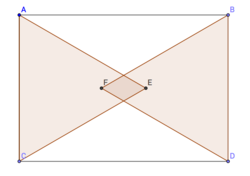Yay for 2014! #7
 Let
A
B
D
C
be a rectangle, as shown above, such that
A
B
=
2
0
and
A
C
=
1
4
.
Points
E
and
F
are located in the interior of
A
B
D
C
such that the triangles
A
E
C
and
B
F
D
are equilateral. The area of the intersection of these triangles can be represented by
Let
A
B
D
C
be a rectangle, as shown above, such that
A
B
=
2
0
and
A
C
=
1
4
.
Points
E
and
F
are located in the interior of
A
B
D
C
such that the triangles
A
E
C
and
B
F
D
are equilateral. The area of the intersection of these triangles can be represented by
b a 3 − c ,
where a , b , and c are positive integers with g cd ( a , b ) = 1 . Find a + b + c .
The answer is 777.
This section requires Javascript.
You are seeing this because something didn't load right. We suggest you, (a) try
refreshing the page, (b) enabling javascript if it is disabled on your browser and,
finally, (c)
loading the
non-javascript version of this page
. We're sorry about the hassle.
3 solutions
Discussions for this problem are now closed
 Hey, why can't I see this image?
Hey, why can't I see this image?
Label points in the diagram as shown above. It is clear that the figure we are trying to find the area of, F G E H , is a rhombus. Thus, if we let [ A B C D ] be the area of A B C D , we have
[ F G E H ] = 2 d 1 d 2 = 2 ( F E ) ( G H ) .
We have
E F = A B − ( I F + E J ) = A B − ( I J − F J + I J − I E ) = 2 0 − ( 2 0 − 7 3 + 2 0 − 7 3 ) = 1 4 3 − 2 0
and
G H = 2 G K = 3 2 F K = 3 F E = 3 1 4 3 − 2 0 = 3 4 2 − 2 0 3 .
Thus,
[ F G E H ] = 2 ( F E ) ( G H ) = 2 ( 1 4 3 − 2 0 ) ( 3 4 2 − 2 0 3 ) = 3 4 9 4 3 − 2 8 0 ,
and a + b + c = 7 7 7 .
I was wondering.. Did you chose the numbers specially so that the answer would be 7 7 7 ?
Actually, no! I didn't expect that when I created this problem. Who knew?
We can find that E F = 1 4 3 − 2 0 .
We can split the rhombus into two triangles (the tip of the large equilateral triangles). We can see that the triangles are similar. The height of the small triangle is half of EF, or 2 1 4 3 − 2 0 = 7 3 − 1 0 .
Using similar triangles, we can find the base to be 7 3 7 3 − 1 0 ⋅ 1 4 = 3 1 4 3 − 2 0 .
The area of the rhombus is twice the area of the triangle, or 2 ⋅ 2 1 ( 7 3 − 1 0 ) ( 3 1 4 3 − 2 0 ) .
We simplify this to get 3 4 9 4 − 2 8 0 3 or 3 4 9 4 3 − 2 8 0 .
Therefore, our final answer is 4 9 4 + 3 + 2 8 0 = 7 7 7 .
Area of the rectangle = 2 8 0
Area of one red triangle = 2 1 × 1 4 2 sin 6 0 = 4 9 3 = A 1
Area of the two white triangles = 2 × 3 1 0 0 3 = 3 2 0 0 3 = A 2
Let the wanted area be X ;
Then, 2 8 0 − A 1 − A 2 = A 1 − X
Solving the equation we get X = 3 4 9 4 3 − 2 8 0